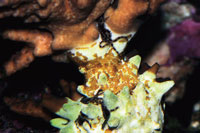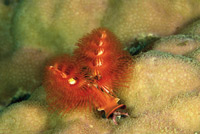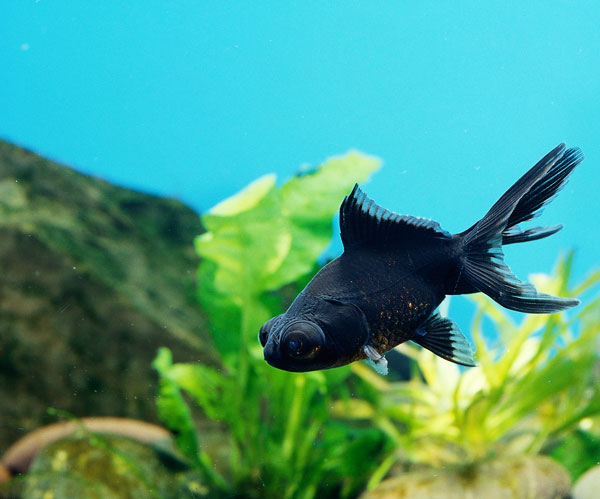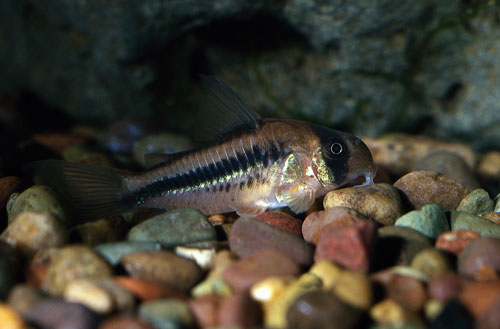
Q. Help! I have been told by two different so-called experts that giving a newly introduced saltwater fish a "freshwater bath" is the best way to prevent possible parasites from entering my saltwater aquarium. This is assuming that, like myself, one doesn't have an extra aquarium or a "hospital" aquarium and cannot medicate the existing aquarium if needed because the aquarium contains live rock. I was also told that most saltwater fish are already stressed from transporting, and they would be stressed even further if they were given a freshwater bath.
I have found very little information on this topic. Some say to use tap water that is dechlorinated, and make sure the pH and temperature are exactly the same as the display aquarium. Then bathe the saltwater fish for approximately five to 10 minutes and, if the fish looks stressed, add it to the aquarium immediately. Is this correct or not? Also does this pertain to certain saltwater invertebrates (e.g., crabs and shrimp)?
I know it's important to always check very carefully for good color, nice structure and make sure the fish is eating well before purchasing it, but this doesn't always mean the saltwater fish being bought is parasite-free! Please help me clear up this issue.
A. I think the freshwater bath can be helpful in eradicating some saltwater fish parasites, but it will not prevent all parasites from entering your aquarium. It works by exposing the single-celled parasites to a markedly different salinity. The osmotic gradient that exists between the parasite's internal environment and its surroundings results in water diffusing into their bodies. This can cause some protozoans to burst like an overfilled balloon!
Unfortunately, the freshwater bath is not 100-percent effective at eliminating all the parasites on a saltwater fish. For example, those parasites that are deeply imbedded in the saltwater fish's mucus, skin or gills will be unaffected by the bath. Some parasites, like saltwater ich (Cryptocaryon irritans) and coral reef disease (Amyloodinium ocellatum), may enter their host's internal organs as well, and are thus unaffected by a freshwater bath.
Studies have shown that Cryptocaryon cysts, which are known as trophonts, can withstand short-term exposure to low salinities. In fact, they can survive in freshwater for up to 18 hours. Other parasites, though not destroyed when a fish is immersed in freshwater, will drop off their hosts. For example, those Amyloodinium cysts not deep in their host's mucus are dislodged when a saltwater fish is placed in freshwater.
Although I have not given a crustacean a freshwater bath, this treatment can be used to rid ailing corals, mushroom anemones and clams of parasites. Simply use the same procedure described below, but only immerse the invertebrate in freshwater for 10 to 5 seconds. Stony corals and clams can tolerate baths lasting as long as one minute.
Administering a freshwater bath is very easy. Just place the saltwater fish in a bucket (which is designated for aquarium use only) that contains dechlorinated tap water, or reverse osmosis water, making sure it's the same temperature and pH as the aquarium water that the fish is being placed into. Leave the saltwater fish in the bucket for two to eight minutes, but watch it carefully, removing it and placing it in the aquarium if it seems extremely distressed (e.g., swims about the bucket erratically, lays on its side, attempts to jump out of the bucket). Some species are more sensitive to being exposed to a freshwater bath than others. For example, wrasses of the genus Pseudocheilinus and mandarin dragonets should not be dipped.
The freshwater in the bucket may contain parasites that have dropped off, so try not to transfer water from the bucket into the aquarium. The best way to avoid this is to quickly lift the saltwater fish out of the bucket and into the aquarium with a soft fish net.
Although freshwater baths can be used to strip a saltwaterfish of some of its parasitic load, the best way to ensure that a fish is healthy before placing it into your display aquarium is to quarantine it. I have had numerous people tell me that they could not afford a quarantine aquarium, only to end up losing an entire aquarium of saltwater fish (that were worth much more than a quarantine setup) to a virulent parasite! In my mind a quarantine aquarium is as important to successful marine fishkeeping as a hydrometer! By quarantining your saltwater fish you will have the opportunity to observe and medicate them appropriately, before they are introduced to the display aquarium.
All you need is a 10-gallon aquarium, a light, a heater, a thermometer, an air pump, an airstone and some saltwater. If you are quarantining larger, more active saltwater fish species then you may need a 30-gallon aquarium. You can use a sponge filter, hang-on-the-back filter or canister filter filled with a plastic filter media (no crushed coral or carbon should be placed in these filters) for biological filtration, but this not essential if you do not overfeed the aquarium and do frequent partial water changes.
If you use a filter, it is essential that after the quarantine period is completed you sterilize the filter and filter media before using it again. To do this, soak the sponge filter, media or the inside of the filter in a mild chlorine solution ( 2-percent chlorine, the rest tap water) for 24 to 48 hours, and then rinse it repeatedly with freshwater until the chlorine smell is gone. To ensure that all the chlorine has been reduced, throw the sponge or filter media in a bucket of freshwater, or place some water in a hang-on-the-back or canister filter and add chlorine remover.
If you are not using an established biological filter, you can just add an air source (e.g., airstone) and do frequent water exchanges (every third day change about 10 to 15 percent of the water) to prevent the buildup of nitrogenous waster products. Although you need to make sure your saltwater fish is properly fed during the quarantine period, it is important not to overfeed. Remove any uneaten fish foods from the aquarium immediately.
The quarantine aquarium should also have plenty of hiding places so that the saltwater fish feel secure and are less stressed. Plastic flowerpots with a hole cut in one side and a rock set on top (to weigh them down) work great, as do sections of PVC pipe. Stay away from hard coral skeletons and any calcium carbonate substrates (e.g., crushed coral) because they pull some medications out of solution and are more difficult to disinfect.
Your quarantine aquarium should not be set up near your display aquarium, because parasites can be spread more easily, and it should have its own set of utensils (e.g., net, thermometer, scrubber pad). The reason for having separate equipment is to prevent the transfer of parasites from the quarantine to the display aquarium. It also possible to transmit pathogens from the quarantine to display aquarium on your hands. To prevent this from occurring, vigorously wash your hands after working in the quarantine aquarium.
Between each quarantine period all utensils, decor and the aquarium should be disinfected. Fill the aquarium full of water, place the utensils and decor in the aquarium, add a small amount of chlorine and let it set for 24 hours. Then remove the water and rinse the aquarium and accessories thoroughly and soak them in tap water with added chlorine remover.
As far as the quarantine procedure is concerned, I would recommend keeping your saltwater fish in quarantine for at least three weeks. It is important to observe them carefully during this period and to promptly treat them if a problem arises. If treatment is necessary, make sure you leave them in quarantine at least 10 days after it is completed to ensure that they have fully recovered. As one last precaution, it is not a bad idea to give your saltwater fish a freshwater bath before moving it from the quarantine to the display aquarium.
One important rule when quarantining is that a saltwater fish must go through the entire three-week process without being exposed to any other fish. If a new saltwater fish is added to the aquarium while another specimen is still being quarantined, you should start the whole three-week process over again.
In summary, the freshwater bath is an effective treatment for helping rid your saltwater fish of some parasites. However, it does not take the place of quarantining your fish.
 Coral and Invertebrate Quarantine Procedures
Coral and Invertebrate Quarantine Procedures
 Catch More Salmon - Follow These Simple To Implement Techniques
FLAT Rigs outriggers, shock cord snubber, and rigging kit i
Catch More Salmon - Follow These Simple To Implement Techniques
FLAT Rigs outriggers, shock cord snubber, and rigging kit i
 Aiptasia
Q. I have Aiptasia all over my aquarium and have been
Aiptasia
Q. I have Aiptasia all over my aquarium and have been
 Fish and Fungus
Black Moor Q. I have two large black moor goldfish, one larg
Fish and Fungus
Black Moor Q. I have two large black moor goldfish, one larg
 Top 10 Fishkeeping Mistakes
Aquarists can say they’ve never made a mistake in their fish
Top 10 Fishkeeping Mistakes
Aquarists can say they’ve never made a mistake in their fish
Copyright © 2005-2016 Pet Information All Rights Reserved
Contact us: www162date@outlook.com